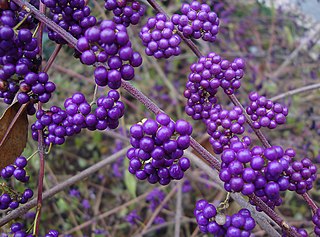This page is based on this
Wikipedia article Text is available under the
CC BY-SA 4.0 license; additional terms may apply.
Images, videos and audio are available under their respective licenses.

Callicarpa ampla, also called the capa rose, is a species of plant in the family Lamiaceae. It is found in Puerto Rico in the Caribbean region. It is threatened by habitat loss and is a critically endangered plant species.

Callicarpa americana is an open-habit, native shrub of the Southern United States which is often grown as an ornamental in gardens and yards. American beautyberries produce large clusters of purple berries, which birds and deer eat, thus distributing the seeds.

Callicarpa bodinieri is a species of flowering plant in the genus Callicarpa of the family Lamiaceae, native to West and Central China. Growing to 3 m (10 ft) tall by 2.5 m (8 ft) wide, it is an upright deciduous shrub with dark green leaves turning red in autumn (fall). In midsummer, small lilac flowers are produced in the leaf axils. But it is grown in gardens primarily for its small, decorative purple berries in tight clusters in autumn. While the berries are not poisonous, they are very bitter. Wildlife will not eat them until there are no other available food sources. This species is more tolerant of cold than C. americana.

Callicarpa japonica, commonly known as East Asian beautyberry or Japanese beautyberry, is a plant in the mint family.

Callicarpa dichotoma is species of beautyberry. They are cultivated as garden trees. The flowers are pink to white. The berries which are small drupes are purple. The fruits grow closely together in large clusters. The fruit provides food for wild life. The berries are bitter and are unfit for culinary use. This species can be found in China, Vietnam, Korea and Japan.

Callicarpa formosana is a species of beautyberry. It is cultivated as an ornamental plant. The drupes resembling tiny clusters of berries are light-purple. The flowers are white. The tree is sometimes used to make herbal medicine. This species ranges from Taiwan to southern Japan.

Callicarpa kwangtungensis is a species of beautyberry. The tree is introduced in Europe as an ornamental plant. The fruit is light-pink and grows in small clusters. The flowers can range from pink to white. It is endemic to China. The berries are very bitter and inedible for human use. Birds and other wild life won't eat them unless all their food sources are depleted.
Callicarpa longifolia is a species of beautyberry. It ranges from the Himalayas, east to Japan and south to Queensland. It is grown in yards and gardens as an ornamental plant. The roots are used as an herbal medicine to treat diarrheas.
Callicarpa erioclona is a species of beautyberry native to Vietnam, Borneo, Sulawesi, Java, Philippines, New Guinea, and the Bismarck Archipelago. It produces small berries that grow in tight clusters. The fruit is edible, but are not commercially grown or sold in markets. The flowers are light-pink to white. The leaves can be mixed with coconut oil to treat open wounds.

Callicarpa acuminata is a species of beautyberry native to Latin America from Mexico to Bolivia. Unlike the other species of this genus, C. acuminata produces small berry-like fruits which can be dark-purple or dark blue-purple. The fruit can sometimes be white. The flowers blooms are white. The fruit grow in tight clumps and sometimes resemble grapes. They are cultivated as garden trees.
Callicarpa cana is a species name previously used to describe two different species of beautyberry:

Callicarpa macrophylla is a species of beautyberry native to the Indian subcontinent. Its fruits are small white berries that actually are drupes.

Callicarpa mollis is a species of beautyberry that is cultivated and grown in gardens and parks as ornamental plant. It has purple flowers. It is found in Korea and Japan.

Callicarpa pedunculata is species of beautyberry native to Australia. It is a small tree or shrub. It produces dark-purple berries that are drupes. The leaves are green to brown. It is grown as an ornamental shrub. The fruit is astringent and too acidic to be eaten by people.
Callicarpa pentandra is a species of beautyberry tree. It's a tall, large tree. The leaves are oval-shaped and the flowers are violet. The berries are green when young but become bright pink to purple when ripe. It ranges from India, Southern China, and the Solomon Islands to Borneo. In Borneo its local names are Belau, Bilau, Guro and Kayu hobo.
Callicarpa rubella is a species of beautyberry native to Southeast Asia. It is a shrub that produces pink or purple flowers followed by dark-purple berries. The berries are actually drupes. It is grown in gardens as an ornamental plant. The fruit attracts wildlife such as birds.

Callicarpa shikokiana, commonly called Shikoku beautyberry or China beautyberry, is a plant species in the Lamiaceae and is native to China. It is a shrub with pink flowers in summer and purple fruit in the fall. The berry-like fruit is a drupe. It is cultivated in home gardens and national parks as an ornamental plant. The leaves turn yellow in the fall.

Callicarpa (beautyberry) is a genus of shrubs and small trees in the family Lamiaceae. They are native to east and southeast Asia, Australia, Madagascar, southeast North America and South America.
Morus cathayana or hua sang is a deciduous tree in the mulberry family which is native to China, Japan and Korea.
Callicarpa candicans is a species of flowering plant in the mint family.













